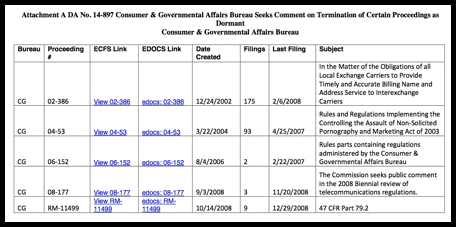VA & FCC: Similarities?
Is the Real Problem Inadequate Throughput Capacity in Both?

Clearly there has been a lot of news recently about the VA and it poor treatment of veterans who have served our country. But no one has said the VA medical staff was sitting by idly as patients were denied treatment or waited excessive times, perhaps to die before treatment. Your blogger believes that while the medical staff was treating patients as fast as they could, the administrative staff at VA covered up a shortfall in capacity by “cooking the books” about waiting times, even if some patients died from delayed treatment.
But is the FCC that different? Consider the recent CG Docket 14-97, “CGB Seeks Comment On Termination of Certain Proceedings as Dormant” in which FCC seeks to close out a 78 page list of proceedings, the first page of which is shown below:
FCC has a glut of open dockets, in February 2011 it estimated there were “more than three thousand open dockets”. While some of these are inevitable, some result from the old “justice delayed, justice denied” metaphor. Readers may recall that after 5 years FCC disposed of the M2Z petition for use of the then vacant AWS-3 band with a phone call saying they were too busy to take formal action. (With later Congressional mandate that federal users had to move out of the lower part of AWS-3, both parts of AWS-3 are now slated for auction).
In Docket 10-44 FCC decided to deal with this glut of open dockets in the following way
“(W)e accordingly amend Section 0.141of our organizational rules to delegate authority to the Chief of the CGB to review allopen dockets periodically. When the CGB Chief identifies an open docket that appears to be a candidate for termination, the CGB Chief will consult with the Commission bureau or office with responsibility for that docket and, with the concurrence of the relevant bureau or office, will take the appropriate action to close the docket after public notice (as discussed in the nextparagraph). Proceedings that are candidates for termination might include dockets in which no further action is required or contemplated and dockets in which no pleadings or other documents have been filed for several years. (Emphasis added)
FCC does not say how many proceedings are on this new list, but I estimate 385 dockets. This follows on a November 1, 2011 order that terminated 999 dockets and a September 27,2012 order that terminated an unspecified number of dockets that I estimate to be about 330. This is a total of 1714 dockets closed as “dormant” in 3 years. Is this a cause for celebration or should someone be asking why are there so many dormant dockets?
Now some of these are truly procedural problems, some are mergers that are now moot because of delays and some are enforcement issues where the violator is no longer in business. But some of these dockets are requests for technical changes in FCC rules that FCC action has delayed to the point where the proponents have just given up and the issue has “died”. We note that the Wireless Innovation NOI, was launched with great fanfare by FCC in 2009 saying it
“seeks to identify concrete steps the Commission can take to support and encourage further innovation and investment in the wireless marketplace. This NOI also seeks to better understand the factors that encourage innovation and investment throughout this area.”
However, by many standards this proceeding is dormant due to FCC inattention. Fortunately, the eccentric serial filer/process abuser Maneesh Pangasa routinely files odd unrelated documents in this docket (145 to date!). Your blogger cross filed in this docket a millimeterwave filing on 02/11/2014. But if only filings by Fortune 500 corporations or their trade associations count, then the last filing was from CTIA on 07/29/2010. So is the Wireless Innovation NOI now dormant and subject to termination by Chief CGB under delegated authority?
Is FCC doing something to decrease the number of dockets that become dormant or will it continue to let dormancy be a routine way of avoiding making decisions?
Are some of FCC’s termination of dormant dockets analogous to VA’s “cooking the books” on waiting times to give the appearance of well functioning organization? While FCC has now created a termination mechanism, it has not done anything to make sure proceedings do not become dormant, perhaps by acting on them before they become dormant! As I indicated in my comments to the House Energy & Commerce Committee I suspect that the fundamental issue here is that FCC as presently structured and operating just does not have the capacity to do its spectrum job. This may not need new legislation to solve, but it at least needs recognition as an real problem, not one swept under the carpet with termination of 100s of proceedings.
When I joined FCC in the Carter Administration, Chmn. Ferris had a phrase “a government worthy of its people” as a test of possible FCC actions. It is still a good phrase as a goal!
UPDATE
Lest you think we are too hard on FCC timeliness, surf over to this CommLawBlog entry on recent revisions to the FCC’s mundane, but important for safety, Antenna Structure Regulations. Peter Tannenwald writes:
If you’ve got one or more tower structures, you may be in luck. The FCC has at long last taken a weed-whacker to Part 17 of its rules, a long-overgrown regulatory briar patch governing the construction, painting and lighting of antenna structures. While the substantive requirements remain largely intact, a number of procedural changes should make life at least a little easier for tower owners as well as the Commission’s Staff. At a minimum, the changes should make the rules easier for real people to grasp.
The only real question here: What took so long? (Emphasis added)
This even affects the cellular industry as well as the broadcasters, but I suspect both have to ration their urgings to FCC to get things done in a timely way. Mr. Tannenwald describes this effort’s timing as follows “Nearly a decade in the making, FCC tower rules brought into the 21st Century”. This is not a docket where presidential appointees confirmed by the Senate add much value, yet it has to go through the same 8th Floor bottleneck.




![Validate my RSS feed [Valid RSS]](valid-rss-rogers.png)

